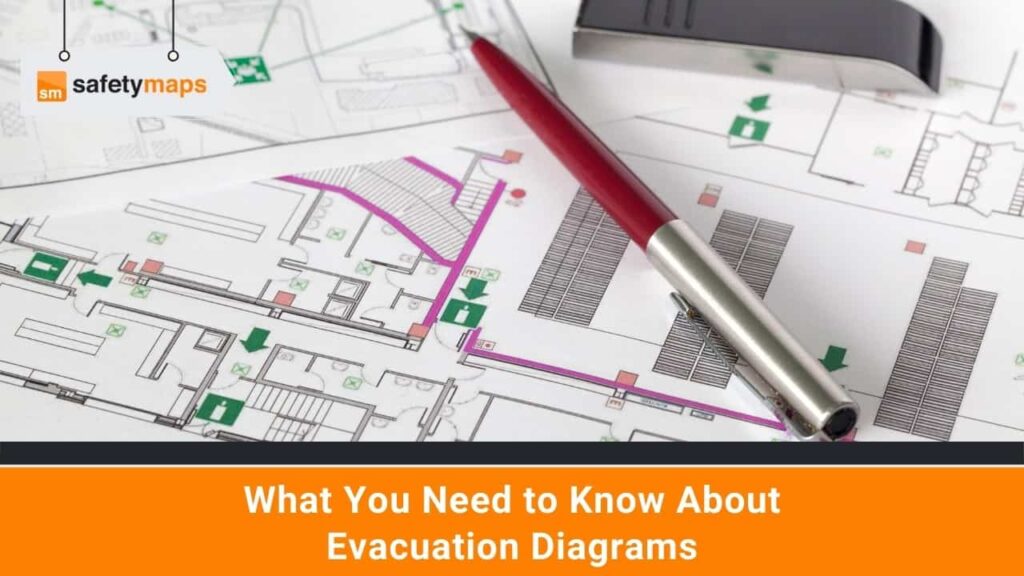Evacuations happen more frequently than people think due to fires and floods. As the amount of time needed to leave the premises depends on the hazard and its severity, evacuation planning become scritical to businesses and the safety of their onsite people. That is where evacuation diagrams come into play.
What is an evacuation diagram?
An evacuation diagram is one of the most important tools to ensure everyone will safely get out of danger when needed. An evacuation diagram is a pictorial representation of how to evacuate a building in case of emergencies. The Australian Standard AS3745:2010 considers this as an essential part of emergency management. It contains vital information such as:
- Emergency information
- Manual call points (MCP)/communication equipment
- Assembly points or areas
- Fixed and portable firefighting equipment
- Exit routes and exit lights
- Emergency procedures
- Fire control rooms
- The creation date and validity of the diagram
- Site name and complete address

Why are evacuation diagrams important?
Evacuation diagrams are so common and incorporated into modern life that it is easy to ignore them. This is similar to how passengers might ignore the flight attendant’s safety demonstration before a plane takes off. But, just like the flight attendant’s safety demonstration, evacuation diagrams help save lives as they provide vital information for crucial moments during an emergency evacuation, allowing people to readily determine their location and find the nearest exit point.
What are the requirements in using evacuation diagrams?
Australian Standard AS 3745:2010 sets specific requirements in terms of the design and location of evacuation diagrams. We outline those below, and they should be placed by the building’s Emergency Planning Committee.
The EPC plays a role in determining the number and location of evacuation diagrams needed. It should consist of at least two members with responsibilities that include developing, implementing, and maintaining the emergency plan in a building or facility.
1. Location
Evacuation diagrams must be on display in locations where visitors and occupants can easily see them, but not on fire doors.
- On entrance doors to hotel rooms or apartments
- On fire stairs
- On fire-rated walls and smoke doors
2. Position
Place the safety diagram at a position not lower than 1200 mm and not higher than 1600 mm from the floor.
3. Orientation
Make sure that the evacuation diagram has the correct orientation with respect to the direction of the egress. The location of the “You are Here” point needs to be accurate as well. The assembly area diagram, if included, should also have the same orientation as the rest of the diagram.
4. Minimum components
Australian Standard AS 3745-2010 specifies the range of components that must be part of the evacuation diagram. This includes designated exits, the location where the diagram is installed, and firefighting equipment.
5. Optional components
Additional information such as other emergency information and equipment, can also be included. However, it is not mandatory. The Emergency Planning Committee will consider these optional components.
6. Dimensions
The evacuation diagram’s minimum size is A4 (approximately 210 mm by 297 mm). The graphic representation of the area or floor should be at least 200 mm by 150 mm. This equates to an area of at least 30,000 mm2.
7. Symbols
Australian Standard AS 3745-2010 Appendix E gives examples of symbols that can be in evacuation diagrams. Always remember that Appendix E is an informative appendix. Note, however, that the details in this section are for reference only. This doesn’t need to be followed to be compliant with Australian Standard AS 3745-2010.
8. Standardised colour codes
Evacuation maps must have standardised codes in accordance with Australian Standard AS 3745 to delineate specific incidents. The colour code is as follows:
- Orange: Evacuation
- Red: Smoke or fire
- Blue: Medical emergency
- Yellow: Internal or Infrastructure emergencies
- Black: Personal threat
- Brown: External emergency
- Purple: Bomb threat

Evacuation diagram update frequency
The evacuation diagram is to be updated every time there are changes in the building’s layout, system, or firefighting equipment or every five years, whichever comes first, and always check the validity date since this is a requirement in all diagrams.
Although the COVID-19 situation has improved and many businesses have resumed operations, precautions still need to be in place. The building layout or usage may be modified to incorporate social distancing, and the evacuation diagram must reflect such changes.
Installing evacuation diagrams
In some cases, the diagrams are acrylic-based signs or acrylic-based poster frame. Other users prefer to make an aluminium poster frame with an acrylic cover. Either way, these are then fixed onto doors using screws, glue, or double-sided tape.
Compliance with the building code of Australia and other standards
Placing diagrams on a smoke or fire door may violate the provisions of the Building Code of Australia. Other relevant Australian Standards like AS 1905.1 may also apply. Testing the installation or seeking expert opinion can help determine how the installation affects the fire or smoke door’s performance.
For instance, the sign’s material or the method of installation may have a negative effect on the door’s integrity and insulation. However, FPA Australia is not yet aware of any evidence that supports this claim at this time.

Training and information dissemination
It’s not enough to simply install evacuation diagrams in strategic locations. The occupants of the building should also receive sufficient information and training to implement evacuation procedures and regular evacuation practice drills need to be done at least once annually.
It is important to note that only qualified personnel should conduct and supervise all the training activities. The training must be given to all occupants at all levels, old and new, permanent, temporary or casual.
What happens when emergency signs don’t comply with AS3745:2010?
Australian Standard AS 3745 is not legally binding. However, this standard has wide recognition in the emergency planning industry as the benchmark in emergency procedure implementation.
Be prepared for emergencies with emergency signs from Safety Maps
There are quite a number of technicalities when it comes to putting emergency signs on the premises. In order to make sure you comply with all the regulations, it’s best to leave the planning and execution to emergency evacuation planning professionals.
If you are looking for assistance in the design and installation of evacuation diagrams, Safety Maps is here to help. We have over 20 years of experience in providing custom design signage across various industries. For more information or a free quote, visit us at safetymaps.com.au, call us on (02) 8078 0302 or send us an email at .


